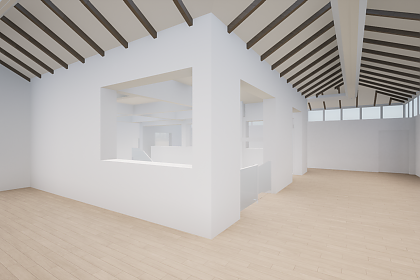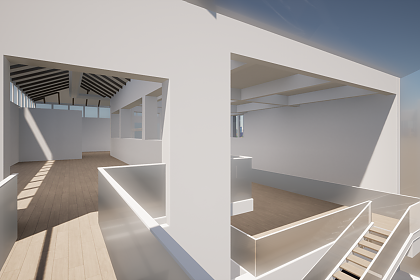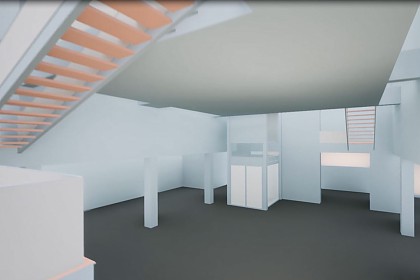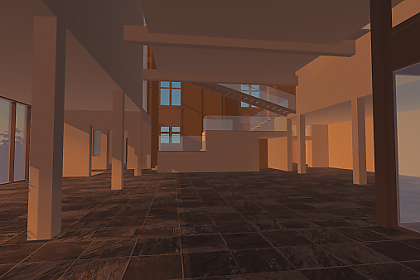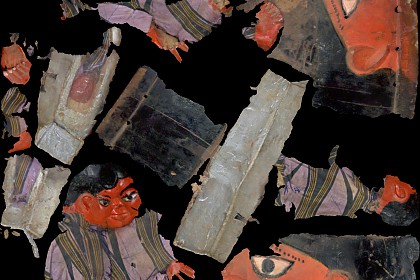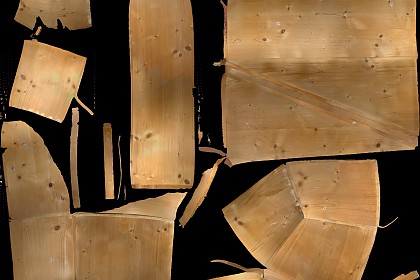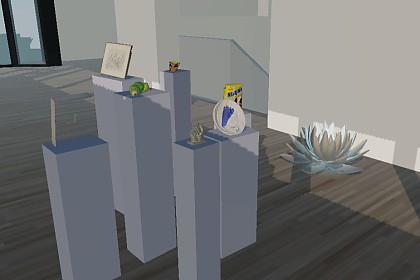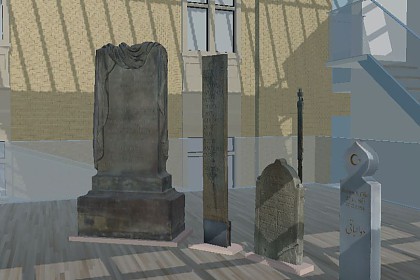

4 Games by the Kunsthochschule Kassel are online!
>> Create exhibitions
>> Search & explore objects
>> play games
>> explore the museum
Rethink Rebuild Restart!
Virtually exploring and redesigning the Museum for Sepulchral Culture
By the end of 2021, the prototype of a digital, participatory museum environment was created as part of the Rethink, Rebuild, Restart! project. Here, interested parties can virtually engage with the collection and the thematics of the Museum for Sepulchral Culture. The project is supported by the initiative "dive in. Program for Digital Interactions" of the Kulturstiftung des Bundes (German Federal Cultural Foundation) with funding by the Federal Government Commissioner for Culture and the Media (BKM) through the NEUSTART KULTUR programme as well as by the cdw Foundation. The focus of Rethink, Rebuild, Restart! is on participatory experience and the question of how the museum and collection can be made more accessible to visitors in terms of participation in the design of exhibitions and collection. The conclusions drawn from the interaction with the virtual museum about the wishes and interests of the users are to be incorporated into the planned redesign of the permanent exhibition of the Museum for Sepulchral Culture. In the future, everyone will be able to access the digital application via a terminal in the museum.
Rethink: Rethinking the Museum – in Virtual Space
3D space
The museum gets a digital twin
Many things are possible in the virtual world that would be unthinkable in physical space. And many things are faster and easier, just as digitality can also complicate life. In order to rethink the museum and explore the possibilities, we have therefore had a virtual twin created that differs from its real-life counterpart. Because: the place, as close to reality as it is recreated, holds the possibility of developing exhibitions in a short time, for which normally years or months of preparation, loan requests, pedestal construction and innumerable other things are necessary. Whoever enters the virtual museum will be confronted with a collection of exhibits that can be found in the real museum, and in some cases with visitations that do not exist in real space: for example, a blue flower, which hides a quietly babbling river, or a red door that leads out of the museum and into a Jewish house of mourning. In the garden of the virtual museum, by the way, there is something that leaves all our possibilities in real space far behind – and challenges our imagination.
Based on a three-dimensional spatial model of the museum, visitors and interested persons can visit and experience the museum's exhibition rooms and collection objects via computer or tablet. This can happen independently of a museum visit, but also in combination to deepen or prepare for an on-site visit. In addition to the digital spaces, collection items can also be explored in the virtual depot, and visitors can curate, build, and share their own exhibitions.
Three steps to virtual space
1. inventory: measure, measure, measure
The museum is measured where information is missing or inaccurate in the floor plans. The data then ends up at an architect's office, where the museum is built up piece by piece in a 3D program. Walls, floors and columns are created. Window openings are set. In some places, we have deviated somewhat from the original and have, for example, dispensed with the escape doors, which are very necessary in reality but superfluous in digital space. The garden, the street and the nearest surrounding parking areas have also been recreated so that visitors can experience not only the museum but also the green spaces that are so characteristic of the Kassel vineyard.
2. interior design
Since we are not capturing an original photo-realistically here, as we do when scanning exhibits, the model is initially devoid of color and materiality. So, to get us away from white walls and floors, we select and apply surfaces and colors that resemble the real museum. There were also "wilder" designs in the beginning, because in digital space, of course, we do not have to represent everything true to nature. However, we soon left behind fantasies of walls glowing green-blue and a pink floor. After all, the museum should also have virtual recognition attributes. And this includes our historic yellow brick wall and our black stone floor.
3. atmosphere
The architect of the real museum, Wilhelm Kücker from Munich, knew what he was doing when he created the museum building, which was built on a historic villa from 1903. He provided openings and light everywhere. Windows in interior and exterior walls and ceilings, completely glazed rooms, and a floating surface halfway between the ground and upper floors create a special atmosphere. Visitors can hear, and often directly see or even smell, almost everything that happens inside the building from almost anywhere in the museum (as an installation of hundreds of dried roses proved to us in 2021). The view into the distance and the sky, brightness and connectedness are now supporting our exhibitions. In virtual space, there is all this too. And the time of day can also be adjusted to suit your mood, so that you can wander through the rooms sometimes accompanied by blue skies and bright sunlight, sometimes by moonlight or sunset.
3D collection
From analog exhibit to 3D object
In addition to the museum building, the inventory of our museum, i.e. our collection, is also being digitized. It continues to grow, because collecting and preserving is one of the central tasks of museums, along with teaching and research. The recording of cultural-historical testimonies is constantly being updated, characterized by innovative ideas and changing traditions. Accordingly, our collection never stands still. In order to be able to take a completely new look at our holdings and, above all, the missing pieces in virtual space, we are working on digitizing our collection as comprehensively as possible. The focus is not only to capture object information and photos, as is usually the case, but also to make them researchable for all interested parties even in the 3D view. This also offers us the opportunity to take another look at data that was recorded many years ago and to supplement it with current findings or links to other objects.
Three steps to the digitized copy
1. the agony of choice: select the first from our 30,000 objects
Our collection comprises around 30,000 exhibits from the fields of sculpture, painting, video, handicrafts and much more. Of course, we intend to use as much of them as possible in the virtual museum. But surely it is not difficult to imagine that the first selection of digital exhibits will be made in such a case. Therefore, we first scanned objects that are also present in the real museum, such as urns, gravestones or death masks. And we have also digitized the first objects from an area that is still underrepresented, namely trans- or intercultural burial and mourning traditions. Next in line will be items of clothing and funerary dances.
2. scan, scan, scan
The selected objects are now brought in and positioned on a scanning station or illuminated in situ (for example, in the case of very large objects) and scanned by hand. This is done with a 3D scanning device, which captures the surface and shape of an object in real time and transmits it to a computer screen. This way, it is always visible where rescanning is still needed and how far the respective object has been captured. The objects are then post-processed on the computer and assembled where necessary (again: very large objects make a lot of work ...). This creates a lifelike image of our collection items or your "digital loans".
3. data acquisition must be
But the fancy 3D model alone does not make a digitized object. There is data for each object that must be transferred to the new application. In addition to an internal object database in which all pieces are recorded, we have also already uploaded numerous objects to museum-digital.de. Material, title, maker or artist, dating, and the provenance of the objects now complete the picture and make it possible to really engage with the objects.
Rebuild: Participate, think, rebuild together
Memorabilia
Personal memorabilia expands the digital collection
Even simple everyday objects, so-called "memorabilia," can be very helpful in coping with the loss of a loved one. A father's pocket knife, which constantly accompanies the son, a watch, jewelry or selected items of clothing can provide comfort and preserve the memory of a loved one in a special way.
Following the existing project "Memorabilia. Things that sustain us", the Museum for Sepulchral Culture invites visitors to become part of the museum collection by contributing their own mementos and anecdotes. Our staff will accept objects that you would like to make available to us as a "digital loan" and store them safely in the depot until they can be digitized by us via 3D scan. You will then receive an acknowledgement of receipt and be informed as soon as your objects have been digitized and you can take them home again. Your memorabilia thus becomes visible to other visitors within the virtual museum environment and adds a valuable piece of memory culture to the digital museum collection. You can also add your personal stories to your memorabilia, anonymously if you wish.
Public scanning
There will also be opportunities to scan your objects directly on site yourself. We will regularly announce when such public scanning days will take place here! Or contact us rightaway, if you have something to share with us.
Where: Museum for Sepulcral Culture
How: register by mail, bring object, scan!
Collection Digitizing
Dr. Ulrike Neurath
Position: Custodian
Telefon: 0561 / 918 93 20
Scanning
Ann-Christin Denecke
Position: 3D digitization of the collection
Telefon: 0561 / 918 93 25
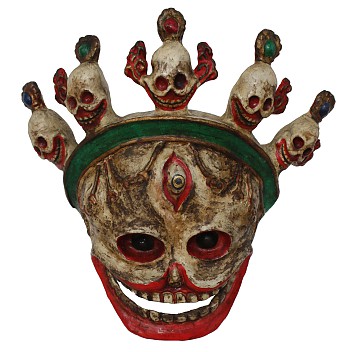
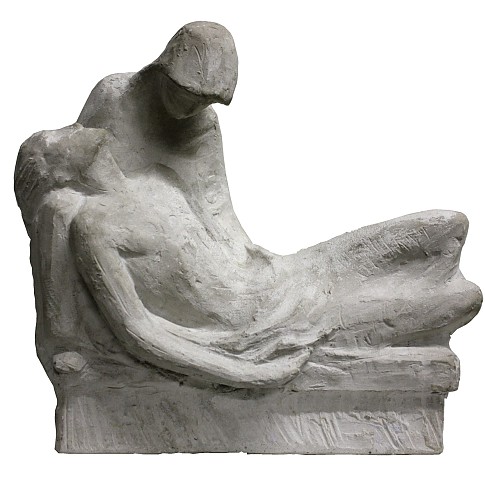




Afterlife
Art, Computer Games and Death
Not only in the Museum for Sepulchral Culture, but also in video games, death often takes on a central role in the midst of the game's action. Hardly any game gets by without the death of the game character. In most games, the "in game death" is not intended as an end point, but initially only as a temporary obstacle. A function that allows players to find new approaches to overcoming problems or to apply new methods for mastering difficult situations. It also allows players to try out alternative choices, sometimes even implicitly intended by the game developers. However, some games punish players for multiple or even single failures by deleting the current game state and the game character, the so-called permadeath, after which the entire game must be restarted. All these approaches give the players the option to learn from decisions made and to ultimately use their own experiences for an optimal course of action by means of direct feedback. An option that real death does not allow us.
Within the project Rethink, Rebuild, Restart! artistic explorations of death in the medium of the computer game are created under the title Aftlerlife. The title Afterlife alludes both to the question of what follows death (an afterlife?) and to the new museum as it will emerge from the renovation and redesign phase of the new conception. Under Afterlife, young artists from the class for computer games at the Kunsthochschule Kassel have been developing their own games embedded in the virtual museum environment since early 2021.
Death as a narrative element driving the action and a game-determining motif therefore plays a role in all the works developed as part of Afterlife. The students approach the themes from very different directions and show various methods of artistic examination and reappraisal. With Sitting Shiva, for example, Joshua Gundlach's work illuminates a Jewish tradition of dealing with the death of relatives and the literal passage through a mourning process as a bereaved person. Albert Gesk, on the other hand, explores in his work the questions of what remains when the features of physical existence disappear, the survival of a spiritual existence cannot be rationally clarified, and how preserving the memory of a person here can take away the fear of death.
The question of whether video games can be considered an art form in their own right or rather an interactive medium for artistic storytelling continues to be debated, in part
controversial. However, at the latest since Bill Viola's so-called experimental "art game" The Night Journey (2007-2018), games have arrived in the discourse of art studies. Far away from established visual artists, a diverse industry is engaged in the development of its own aesthetics, formal and visual languages and thus creates narratively and visually dense digital works that have nothing whatsoever to do with the outdated prejudice of shallow niche entertainment for children.
In cooperation with
Games Class
Prof. Auriea Harvey B.F.A.
Position: Professor of the Games Class, KHK Kassel
Sitting Shiva
Joshua Gundlach
Joshua Gundlach's work Sitting Shiva addresses the mourning of a person who is "sitting shiva." A Jewish tradition of mourning in which the bereaved are expected to stay at home for a week after the funeral of a loved one, not to engage in professional or domestic work, and to focus on mourning during this time. Friends and the community come together during this time to support, comfort and signal the grieving that you are not alone in your grief. Grief rites also include saying special prayers together.
In Sitting Shiva, the person playing is immersed in the role of a grieving person who allegorically walks through the psychological effects of grief in search of an exit, the end of the mourning period. Like the state of mourning itself, the game environment of Sitting Shiva does not always follow the physical rules of space and time.
Memory Bouquet
Yifan Zhou
Yifan Zhou's Memory Bouquet is based on wax-covered bouquets of flowers from a cemetery nursery owned by the artist Karoline Bräg.
Like the wax-covered bouquets, memories of the deceased retain their form and meaning, even if their colors, intensity and clarity fade over time. The grave flowers also represent the grief and longing of the bereaved, as well as the memory of the deceased loved one. At the same time, Zhou weaves traditional Chinese aspects of dealing with death into her work. Small water lilies can be tagged with messages and placed in the river. This creates an intimate mourning space that is only visible to the person who created it. Whether the short messages contain a dialogue, a memory or just the name of a deceased person is up to them. The wax river becomes a digital book of condolence in which viewers have the opportunity to reconnect with loved ones who have died, to share the unsaid, or to share in the grief of others.

Desperate Attempt
Albert Gesk
In his work Desperate Attempt, Albert Gesk deals with the fundamental question of the personal approach to death and transience. What remains after the death of a person and his identity, if he does not believe in an afterlife or an existence after death? What makes a person immortal? Is it the memories of those left after the physical evidence of a life no longer exists? Is there a way to leave a permanent imprint of one's existence for posterity, and could such an option remove the fear of one's own impermanence?
In Desperate Attempt, players climb a staircase above the rooftops of Kassel. This staircase spirals around an alien monolith, which is the goal of the players. On each new floor, players are confronted with questions about their personal approach to death. When players reach the end of the path, they can leave a lasting message on the surface of the monolith. But what do we want to leave behind for our posterity and can the essence of an existence be captured in 300 characters?

Quiz of Death
By Luna Hirt and Stefan Kreller
As the name suggests, the "Quiz of Death" is a classic quiz that offers visitors the opportunity to test their knowledge on the topics of the Museum for Sepulchral Culture. The idea resulted from a research on the topic of death, from which a lot of interesting knowledge, but also "fun facts" emerged. Those who have already been to the museum certainly have an advantage, but for everyone else there are tricky and not so tricky questions - and above all detailed explanations of the correct answers.
Holey, tattered, crumpled: that's probably what best describes the style of this game. For the cemetery, the Luther Church in Kassel and surrounding gravestones were "scanned" using photogrammetry (a digital image is created based on many photos of a real object). The result was a locally familiar, atmospheric environment that creates the setting for three figures competing against each other.
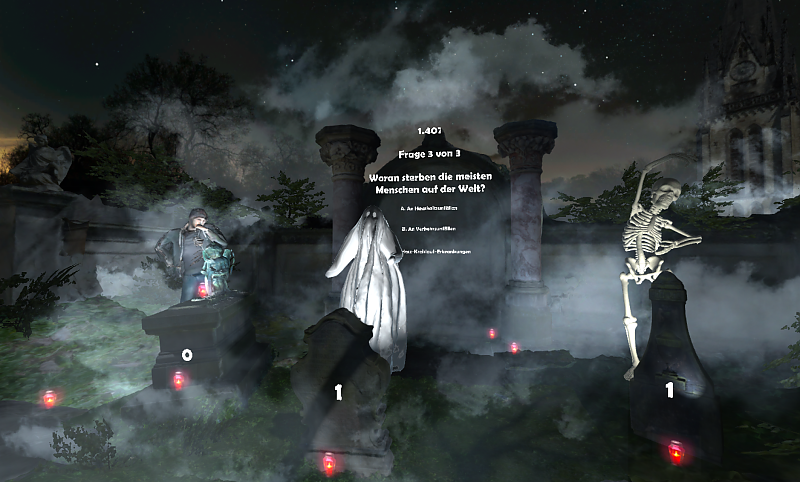
Participation for schools
The virtual museum as an extracurricular place of learning
School classes from elementary school to vocational school have been learning and researching with us for 30 years. With the virtual museum, there are now completely new possibilities. Students can borrow IPads on site at the museum and use them to explore the virtual and real museum at the same time. They can digitally learn more about the exhibits they can find in real life or curate their own exhibitions. Topics from religion, ethics or history lessons can provide incentives for this. Or perhaps the school class is also concerned with digitality and digitization? After all, these are topics that are currently generating an increasing number of innovations, changes and questions.
If you can't or don't want to visit the museum on site, the project can of course also take place completely digitally. The virtual museum can be accessed via any web browser. In addition, we have also been offering online tours or seminars for some time now, so that school lessons have also become possible in this way – and have become an everyday reality for teachers and students in recent months.
Together with schools, we would also like to continuously expand the teaching and learning opportunities with the new virtual museum version. Therefore, we are also looking forward to closer and longer-term partnerships for joint development and expansion.
Downloads
You can find initial incentives on how to use the virtual museum here.
How to make an exhibition?
>> Download (PDF) (German, to be translated soon)
Not the right one? We are constantly developing further concepts and worksheets - and are also happy to receive suggestions from you!
We are looking for partner schools!
If you are a school principal, teacher or student representative and would like to work with us on the virtual museum, please contact us.
We look forward to your questions and ideas!
Contact
Gerold Eppler M.A.
Position: Deputy Director, Museum Education
Telefon: 0561 / 918 93 23
Restart: rebuild, dust off, expand and reopen!
Redesign
Why all this?
We are remodeling the museum and the permanent exhibition – and are already rehearsing virtually!
The museum will close at the end of 2023 and be completely renovated, modernized and, above all, equipped with a new permanent exhibition. Because: The current permanent exhibition has already lasted too long. It does not sufficiently depict the sepulchral culture of our society, in which, in addition to new ways of designing cemeteries and gravestones and dealing with mourners, the influence of migration on religious and cultural diversity or current findings in medicine have made themselves directly felt and have initiated and brought about transformative processes.
The Museum for Sepulchral Culture is a place meant for everyone. It is a platform of exchange, research and mediation and, of course, of the continuous expansion of its holdings for the purpose of an exhibition work that always participates in contemporary events. For this reason, we consider it a logical consequence to involve all those who wish to do so in the project of redesigning the permanent exhibition.
The program "Rethink, Rebuild, Restart!" stands for the process towards this new museum. We are rethinking, redesigning and then starting in 2025 with a brand new permanent presentation.
How exactly does that work?
In one year, we have now virtually recreated the museum and started to virtualize our holdings with 3D technology. Young artists have developed small or large games that bring the digital spaces to life. And we have created an interface through which anyone who feels like sharing their own idea of an interesting exhibition at the Museum für Sepulkralkultur can do just that. In short, everyone can now join us in asking: What could the new permanent exhibition at the Museum for Sepulchral Culture look like? Which themes are essential?
In the application, we can add objects to the virtual collection that we may have missed before. We can be taken into the aesthetic world of artistic games and enter a Jewish house of mourning or shoot last thoughts into space with each other. And we can create exhibitions with the exhibits of the digital collection, write wall texts and look at what ideas and approaches other visitors to the virtual museum have implemented. All this helps us to redesign the museum according to the needs of many.
Chatforum
Let's exchange ideas!
If you have familiarized yourself with the project up to this point, it has certainly become clear: It only works through dialog. Therefore, we welcome your questions, suggestions and criticism!
Of course, you can also use this forum to share your impressions with other visitors to the virtual museum or, for example, to let them know that you have created and published your own exhibition that we can all now view. This will keep everyone up to date on what is happening in the virtual space.
Please be sure to communicate in a friendly and considerate manner. Posts will first be forwarded to the museum administration and then approved – or deleted if they contain offensive or other inappropriate content.
Arbeitsgemeinschaft Friedhof und Denkmal e. V.
Telefon: 0 561 / 918 93 0
Fax: 0 561 / 918 93 10
Weinbergstraße 25-27
34117 Kassel
Sponsoring & Partners
The project Rethink, Rebuild, Restart! is supported by the initiative
"dive in. Program for Digital Interactions" of the Kulturstiftung des Bundes
(German Federal Cultural Foundation) with funding by the
Federal Government Commissioner for Culture and the Media (BKM)
through the NEUSTART KULTUR programme
Logo by Krastev+Krastev
Krastev+Krastev auf der Shortlist!
Unser wundervolles Logo nebst Animationen, Fahnen und Flyern wurde von Krastev und Krastev Design Bureau in Kassel geschaffen. Dahinter verbergen sich Jessica und Milen Krastev, die in Kassel zudem die Kunstgalerie Coucou betreiben. Das von den beiden gestaltete Logo für "Rethink, Rebuild, Restart" ist nun auf der Shortlist des renommierten Wettbewerbs des 101st ADC Annual Awards New York. Eine tolle Auszeichnung, neben großen Firmen nun das Museum für Sepulkralkultur unter den Auftraggebern für die besten Designlösungen des Jahres zu finden. Wir freuen uns riesig und danken Krastev und Krastev!

Arbeitsgemeinschaft Friedhof und Denkmal e.V.
Zentralinstitut für Sepulkralkultur
Museum für Sepulkralkultur
Weinbergstraße 25–27
D-34117 Kassel | Germany
Tel. +49 (0)561 918 93-0
info@sepulkralmuseum.de




